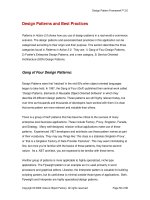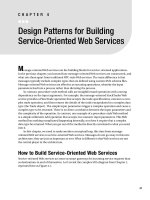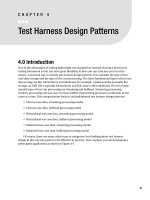Mastering python design patterns sakis kasampalis
Bạn đang xem bản rút gọn của tài liệu. Xem và tải ngay bản đầy đủ của tài liệu tại đây (1.96 MB, 222 trang )
Table of Contents
Mastering Python Design Patterns
Credits
About the Author
About the Reviewers
www.PacktPub.com
Support files, eBooks, discount offers, and more
Why subscribe?
Free access for Packt account holders
Preface
Design patterns
Common misunderstandings about design patterns
Design patterns and Python
What this book covers
What you need for this book
Who this book is for
Conventions
Reader feedback
Customer support
Downloading the example code
Errata
Piracy
Questions
1. The Factory Pattern
Factory Method
A real-life example
A software example
Use cases
Implementation
Abstract Factory
A real-life example
A software example
Use cases
Implementation
Summary
2. The Builder Pattern
A real-life example
A software example
Use cases
Implementation
3.
4.
5.
6.
7.
8.
9.
Summary
The Prototype Pattern
A real-life example
A software example
Use cases
Implementation
Summary
The Adapter Pattern
A real-life example
A software example
Use cases
Implementation
Summary
The Decorator Pattern
A real-life example
A software example
Use cases
Implementation
Summary
The Facade Pattern
A real-life example
A software example
Use cases
Implementation
Summary
The Flyweight Pattern
A real-life example
A software example
Use cases
Implementation
Summary
The Model-View-Controller Pattern
A real-life example
A software example
Use cases
Implementation
Summary
The Proxy Pattern
A real-life example
A software example
Use cases
Implementation
Summary
10. The Chain of Responsibility Pattern
A real-life example
A software example
Use cases
Implementation
Summary
11. The Command Pattern
A real-life example
A software example
Use cases
Implementation
Summary
12. The Interpreter Pattern
A real-life example
A software example
Use cases
Implementation
Summary
13. The Observer Pattern
A real-life example
A software example
Use cases
Implementation
Summary
14. The State Pattern
A real-life example
A software example
Use cases
Implementation
Summary
15. The Strategy Pattern
A real-life example
A software example
Use cases
Implementation
Summary
16. The Template Pattern
A real-life example
A software example
Use cases
Implementation
Summary
Index
Mastering Python Design Patterns
Mastering Python Design Patterns
Copyright © 2015 Packt Publishing
All rights reserved. No part of this book may be reproduced, stored in a retrieval system, or
transmitted in any form or by any means, without the prior written permission of the
publisher, except in the case of brief quotations embedded in critical articles or reviews.
Every effort has been made in the preparation of this book to ensure the accuracy of the
information presented. However, the information contained in this book is sold without
warranty, either express or implied. Neither the author, nor Packt Publishing, and its dealers
and distributors will be held liable for any damages caused or alleged to be caused directly
or indirectly by this book.
Packt Publishing has endeavored to provide trademark information about all of the
companies and products mentioned in this book by the appropriate use of capitals.
However, Packt Publishing cannot guarantee the accuracy of this information.
First published: January 2015
Production reference: 1220115
Published by Packt Publishing Ltd.
Livery Place
35 Livery Street
Birmingham B3 2PB, UK.
ISBN 978-1-78398-932-4
www.packtpub.com
Credits
Author
Sakis Kasampalis
Reviewers
Evan Dempsey
Amitabh Sharma
Yogendra Sharma
Patrycja Szabłowska
Commissioning Editor
Kunal Parikh
Acquisition Editor
Owen Roberts
Content Development Editor
Sumeet Sawant
Technical Editors
Tanvi Bhatt
Gaurav Suri
Copy Editors
Shivangi Chaturvedi
Nithya P.
Adithi Shetty
Project Coordinator
Aboli Ambardekar
Proofreaders
Ameesha Green
Joyce Littlejohn
Indexer
Tejal Soni
Graphics
Abhinash Sahu
Production Coordinator
Aparna Bhagat
Cover Work
Aparna Bhagat
About the Author
Sakis Kasampalis (@SKasampalis) is a software engineer living in the Netherlands. He is
not dogmatic about particular programming languages and tools; his principle is that the
right tool should be used for the right job. One of his favorite tools is Python because he
finds it very productive.
Sakis was also the technical reviewer of Mastering Object-oriented Python and Learning
Python Design Patterns, published by Packt Publishing.
I want to thank my sweetheart, Georgia, for supporting this effort. Many thanks to
Owen Roberts who encouraged me to write this book. I also want to thank Sumeet
Sawant for being a very kind and cooperative content development editor. Last but not
least, I want to thank the reviewers of this book for their valuable feedback.
About the Reviewers
Evan Dempsey is a software developer from Waterford, Ireland. When he isn't hacking in
Python for fun and profit, he enjoys craft beers, common Lisp, and keeping up with modern
research in machine learning. He is a contributor to several open source projects.
Amitabh Sharma is a professional software engineer. He has worked extensively on
enterprise applications in telecommunications and business analytics. His work is focused
on service-oriented architecture, data warehouses, and languages such as Java, Python,
and others.
I would like to thank my grandfather and my father for allowing me to learn all that I can.
I would also like to thank my wife, Komal, for her support and encouragement.
Yogendra Sharma was born and brought up in a small but cultural town, Pratapgarh, in the
state of Rajasthan. His basic education has been imparted in his hometown itself, and he
completed his BTech in Computer Science from Jaipur. He is basically an engineer by heart
and a technical enthusiast by nature.
He has vast experience in the fields of Python, Django framework, web app security,
networking, Web 2.0, and C++.
Along with CCNA, many other esteemed certifications have been awarded to him. He is an
active member of International Association of Engineers, Ubuntu, India, and Computer
Society of India.
More recently, he participated in bug bounty programs and won many bug bounties,
including the respected Yahoo, Ebay, PayPal bug bounty. He has been appointed as
security researcher for several respected organizations, such as Adobe, Ebay, Avira,
Moodle, Cisco, Atlassian, Basecamp, CodeClimate, Abacus, Rediff, Assembla,
RecruiterBox, Tumbler, Wrike, Indeed, HybridSaaS, Sengrid, and SnapEngag.
He has reviewed many books from reputed publishing houses. You can find him on LinkedIn
at />I would like to thank all my friends who always encouraged me to do something new
and believing in me.
Patrycja Szabłowska is a Python developer with some Java background, with experience
mainly in backend development. She graduated from Nicolaus Copernicus University in
Toruń, Poland.
She is currently working in Warsaw, Poland, at Grupa Wirtualna Polska. She is constantly
exploring technical novelties and is open-minded and eager to learn about the next Python
library or framework. Her favorite programming motto is Code is read much more often
than it is written.
I'd like to thank my husband, Wacław, for encouraging me to explore new frontiers, and
also my parents for teaching me what matters the most.
www.PacktPub.com
Support files, eBooks, discount offers, and
more
For support files and downloads related to your book, please visit www.PacktPub.com.
Did you know that Packt offers eBook versions of every book published, with PDF and
ePub files available? You can upgrade to the eBook version at www.PacktPub.com and as
a print book customer, you are entitled to a discount on the eBook copy. Get in touch with
us at <> for more details.
At www.PacktPub.com, you can also read a collection of free technical articles, sign up for
a range of free newsletters and receive exclusive discounts and offers on Packt books and
eBooks.
/>Do you need instant solutions to your IT questions? PacktLib is Packt's online digital book
library. Here, you can search, access, and read Packt's entire library of books.
Why subscribe?
Fully searchable across every book published by Packt
Copy and paste, print, and bookmark content
On demand and accessible via a web browser
Free access for Packt account holders
If you have an account with Packt at www.PacktPub.com, you can use this to access
PacktLib today and view nine entirely free books. Simply use your login credentials for
immediate access.
Preface
Design patterns
In software engineering, a design pattern is a recommended solution to a software design
problem. Design patterns generally describe how to structure our code to solve common
design problems using best practices. It is important to note that a design pattern is a highlevel solution; it doesn't focus on implementation details such as algorithms and data
structures [GOF95, page 13], [j.mp/srcmdp]. It is up to us, as software engineers, to
decide which algorithm and data structure is optimal to use for the problem we are trying to
solve.
Note
If you are wondering what is the meaning of the text within [], please jump to the
Conventions section of this preface for a moment to see how references are formatted
in this book.
The most important part of a design pattern is probably its name. The benefit of naming all
patterns is that we have, on our hands, a common vocabulary to communicate [GOF95,
page 13]. Thus, if you send some code for review and your peer reviewer gives feedback
mentioning "I think that you can use a Strategy here instead of ...", even if you don't know
or remember what a strategy is, you can immediately look it up.
As programming languages evolve, some design patterns such as Singleton become
obsolete or even antipatterns [j.mp/jalfdp], others are built in the programming language
(iterator), and new patterns are born (Borg/Monostate [j.mp/amdpp], [j.mp/wikidpc]).
Common misunderstandings about design
patterns
There are a few misunderstandings about design patterns. One misunderstanding is that
design patterns should be used right from the start when writing code. It is not unusual to
see developers struggling with which pattern they should use in their code, even if they
haven't first tried to solve the problem in their own way [j.mp/prsedp], [j.mp/stedp].
Not only is this wrong, but it is also against the nature of design patterns. Design patterns
are discovered (in contrast to invented) as better solutions over existing solutions. If you
have no existing solution, it doesn't make sense to look for a better one. Just go ahead and
use your skills to solve your problem as best as you think. If your code reviewers have no
objections and through time you see that your solution is smart and flexible enough, it
means that you don't need to waste your time on struggling about which pattern to use. You
might have even discovered a better design pattern than the existing one. Who knows? The
point is do not limit your creativity in favor of forcing yourself to use existing design patterns.
A second misunderstanding is that design patterns should be used everywhere. This results
in creating complex solutions with unnecessary interfaces and hierarchies, where a simpler
and straightforward solution would be sufficient. Do no treat design patterns as a panacea
because they are not. They must be used only if there is proof that your existing code
"smells", and is hard to extend and maintain. Try thinking in terms of you aren't gonna need
it (YAGNI [j.mp/c2yagni]) and Keep it simple stupid (KISS [j.mp/wikikis]). Using design
patterns everywhere is as evil as premature optimization [j.mp/c2pro].
Design patterns and Python
This book focuses on design patterns in Python. Python is different than most common
programming languages used in popular design patterns books (usually Java [FFBS04] or
C++ [GOF95]). It supports duck-typing, functions are first-class citizens, and some patterns
(for instance, iterator and decorator) are built-in features. The intent of this book is to
demonstrate the most fundamental design patterns, not all patterns that have been
documented so far [j.mp/wikidpc]. The code examples focus on using idiomatic Python
when applicable [j.mp/idiompyt]. If you are not familiar with the Zen of Python, it is a good
idea to open the Python REPL right now and execute import this. The Zen of Python is
both amusing and meaningful.
What this book covers
Part 1: Creational patterns presents design patterns that deal with object creation.
Chapter 1, The Factory Pattern, will teach you how to use the Factory design pattern
(Factory Method and Abstract Factory) to initialize objects, and cover the benefits of using
the Factory design pattern instead of direct object instantiation.
Chapter 2, The Builder Pattern, will teach you how to simplify the creation of objects that
are typically composed by more than one related objects.
Chapter 3, The Prototype Pattern, will teach you how to create a new object that is a full
copy (hence, the name clone) of an existing object.
Part 2: Structural patterns presents design patterns that deal with relationships between the
entities (classes, objects, and so on) of a system.
Chapter 4, The Adapter Pattern, will teach you how to make your existing code compatible
with a foreign interface (for example, an external library) with minimal changes.
Chapter 5, The Decorator Pattern, will teach you how to enhance the functionality of an
object without using inheritance.
Chapter 6, The Facade Pattern, will teach you how to create a single entry point to hide the
complexity of a system.
Chapter 7, The Flyweight Pattern, will teach you how to reuse objects from an object pool
to improve the memory usage and possibly the performance of your applications.
Chapter 8, The Model-View-Controller Pattern, will teach you how to improve the
maintainability of your applications by avoiding mixing the business logic with the user
interface.
Chapter 9, The Proxy Pattern, will teach you how to improve the security of your application
by adding an extra layer of protection.
Part 3: Behavioral patterns presents design patterns that deal with the communication of
the system's entities.
Chapter 10, The Chain of Responsibility Pattern, will teach you how to send a request to
multiple receivers.
Chapter 11, The Command Pattern, will teach you how to make your application capable of
reverting already applied operations.
Chapter 12, The Interpreter Pattern, will teach you how to create a simple language on top
of Python, which can be used by domain experts without forcing them to learn how to
program in Python.
Chapter 13, The Observer Pattern, will teach you how to send notifications to the
registered stakeholders of an object whenever its state changes.
Chapter 14, The State Pattern, will teach you how to create a state machine to model a
problem and the benefits of this technique.
Chapter 15, The Strategy Pattern, will teach you how to pick (during runtime) an algorithm
between many available algorithms, based on some input criteria (for example, the element
size).
Chapter 16, The Template Pattern, will teach you how to make a clear separation between
the common and different parts of an algorithm to avoid unnecessary code duplication.
What you need for this book
The code is written exclusively in Python 3. Python 3 is, in many aspects, not compatible
with Python 2.x [j.mp/p2orp3]. The focus is on Python 3.4.0 but using Python 3.3.0 should
also be fine, since there are no syntax differences between Python 3.3.0 and Python 3.4.0
[j.mp/py3dot4]. In general, if you install the latest Python 3 version from www.python.org,
you should be fine with running the examples. Most modules/libraries that are used in the
examples are a part of the Python 3 distribution. If an example requires any extra modules
to be installed, instructions on how to install them are given before presenting the related
code.
Who this book is for
The audience of this book is Python programmers with an intermediate background and an
interest in design patterns implemented in idiomatic Python. Programmers of other
languages who are interested in Python can also benefit, but it's better if they first read
some materials that explain how things are done in Python [j.mp/idiompyt], [j.mp/dspython].
Conventions
In this book, you will find a number of text styles that distinguish between different kinds of
information. Here are some examples of these styles and an explanation of their meaning.
Code words in text, database table names, folder names, filenames, file extensions,
pathnames, dummy URLs, user input, and Twitter handles are shown as follows: "We will
use two libraries that are part of the Python distribution for working with XML and JSON:
xml.etree.ElementTree and json."
A block of code is set as follows:
@property
def parsed_data(self):
return self.data
When we wish to draw your attention to a particular part of a code block, the relevant lines
or items are set in bold:
@property
def parsed_data(self):
return self.data
Any command-line input or output is written as follows:
>>> python3 factory_method.py
New terms and important words are shown in bold. Words that you see on the screen,
for example, in menus or dialog boxes, appear in the text like this: "Clicking the Next button
moves you to the next screen."
Note
Warnings or important notes appear in a box like this.
Tip
Tips and tricks appear like this.
Book references follow the format [Author, page]. For example, the reference [GOF95,
page 10] refers to the 10th page of the GOF (Design Patterns: Elements of Reusable
Object-Oriented Software) book. At the end of the book, there is a section devoted to all
book references.
Web references follow the format [j.mp/shortened]. These are shortened URL addresses
that you can type or copy/paste into your web browser and be redirected to the real
(usually longer and sometimes uglier) web reference. For example, typing j.mp/idiompyt in
you web browser's address bar should redirect you to
/>
Reader feedback
Feedback from our readers is always welcome. Let us know what you think about this book
—what you liked or disliked. Reader feedback is important for us as it helps us develop
titles that you will really get the most out of.
To send us general feedback, simply e-mail <>, and mention the
book's title in the subject of your message.
If there is a topic that you have expertise in and you are interested in either writing or
contributing to a book, see our author guide at www.packtpub.com/authors.
Customer support
Now that you are the proud owner of a Packt book, we have a number of things to help you
to get the most from your purchase.
Downloading the example code
You can download the example code files from your account at
for all the Packt Publishing books you have purchased. If you purchased this book
elsewhere, you can visit and register to have the files emailed directly to you.
Errata
Although we have taken every care to ensure the accuracy of our content, mistakes do
happen. If you find a mistake in one of our books—maybe a mistake in the text or the code
—we would be grateful if you could report this to us. By doing so, you can save other
readers from frustration and help us improve subsequent versions of this book. If you find
any errata, please report them by visiting selecting
your book, clicking on the Errata Submission Form link, and entering the details of your
errata. Once your errata are verified, your submission will be accepted and the errata will
be uploaded to our website or added to any list of existing errata under the Errata section
of that title.
To view the previously submitted errata, go to
and enter the name of the book in the
search field. The required information will appear under the Errata section.
Piracy
Piracy of copyrighted material on the Internet is an ongoing problem across all media. At
Packt, we take the protection of our copyright and licenses very seriously. If you come
across any illegal copies of our works in any form on the Internet, please provide us with
the location address or website name immediately so that we can pursue a remedy.
Please contact us at <> with a link to the suspected pirated
material.
We appreciate your help in protecting our authors and our ability to bring you valuable
content.
Questions
If you have a problem with any aspect of this book, you can contact us at
<>, and we will do our best to address the problem.
Chapter 1. The Factory Pattern
Creational design patterns deal with an object creation [j.mp/wikicrea]. The aim of a
creational design pattern is to provide better alternatives for situations where a direct object
creation (which in Python happens by the __init__() function [j.mp/divefunc], [Lott14, page
26]) is not convenient.
In the Factory design pattern, a client asks for an object without knowing where the object
is coming from (that is, which class is used to generate it). The idea behind a factory is to
simplify an object creation. It is easier to track which objects are created if this is done
through a central function, in contrast to letting a client create objects using a direct class
instantiation [Eckel08, page 187]. A factory reduces the complexity of maintaining an
application by decoupling the code that creates an object from the code that uses it
[Zlobin13, page 30].
Factories typically come in two forms: the Factory Method, which is a method (or in
Pythonic terms, a function) that returns a different object per input parameter
[j.mp/factorympat]; the Abstract Factory, which is a group of Factory Methods used to
create a family of related products [GOF95, page 100], [j.mp/absfpat].
Factory Method
In the Factory Method, we execute a single function, passing a parameter that provides
information about what we want. We are not required to know any details about how the
object is implemented and where it is coming from.
A real-life example
An example of the Factory Method pattern used in reality is in plastic toy construction. The
molding powder used to construct plastic toys is the same, but different figures can be
produced using different plastic molds. This is like having a Factory Method in which the
input is the name of the figure that we want (duck and car) and the output is the plastic
figure that we requested. The toy construction case is shown in the following figure, which
is provided by www.sourcemaking.com [j.mp/factorympat].









